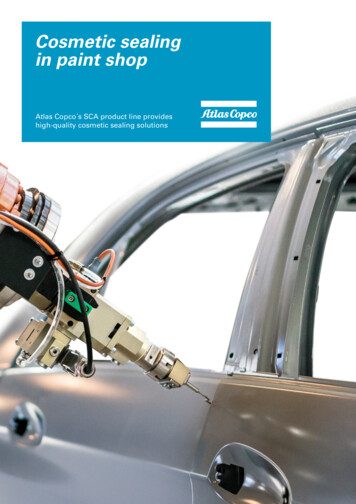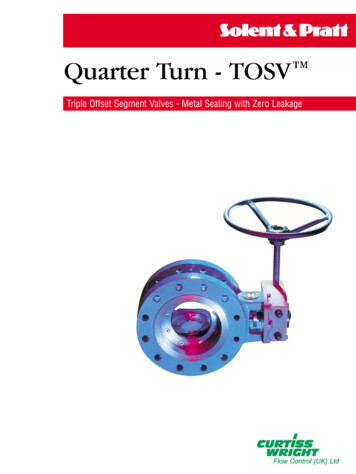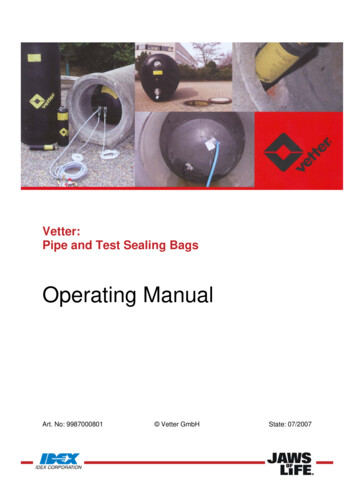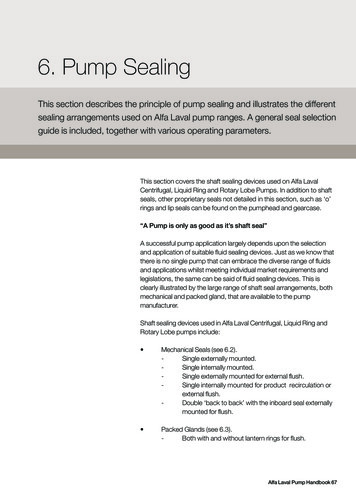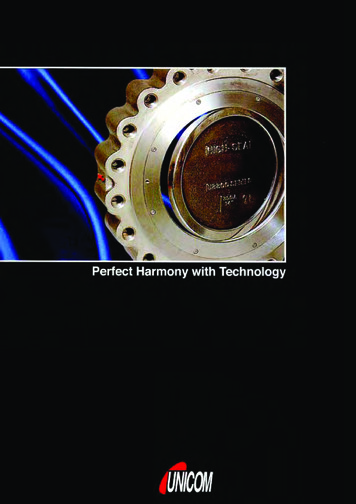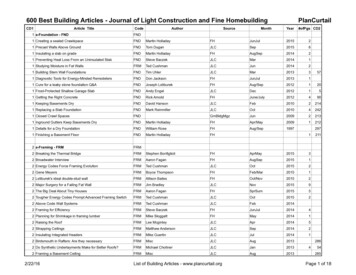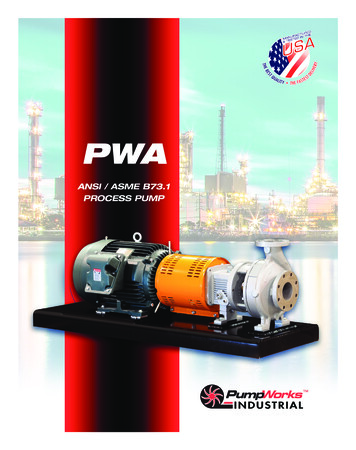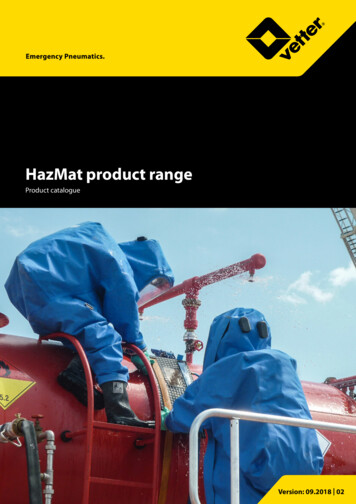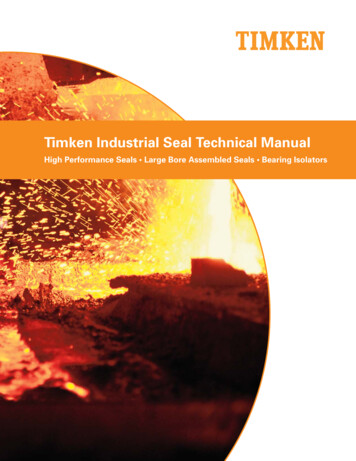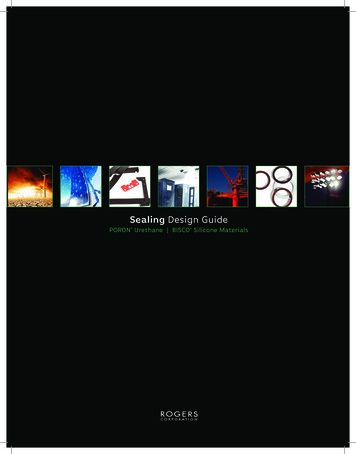
Transcription
Sealing Design GuidePORON Urethane BISCO Silicone Materials
Sealing Design GuideSUCCESSFUL ENCLOSURES RELY ON ALL ASPECTS OF THEDESIGN TO MAKE AN EFFECTIVE SEAL.This guide presents comparison test data on sealing materials while highlightingessential criteria for long-term sealing solutions in many enclosure applications.The accompanying research acts as a reference for material selection, while servingto better educate the market on Rogers’ materials.ENCLOSURE STANDARDSSeals are used in industrial, electrical, and electronic applications to keep in what’smeant to be in and keep out what’s meant to be out.Four types of gaskets – strip, die-cut, form-in-place and bulb extrusion – help toseal according to the requirements of four of the most common standards:pN ational Electrical Manufacturer’s Association (NEMA)*:Ratings are numbered. Most common for indoor applications are 12 and 13,while 3, 4, 4x, 6 and 6P are most common for outdoor applications.pUnderwriters Laboratories (UL): Ratings are similar to NEMA.pI nternational Electrotechnical Commission (IEC): IP-XX (ingress protection)codes specify protection required.pCanadian Standards Association (CSA)*Note: NEMA only provides guidelines, not certificationMultiple factors, including enclosure and gasket design, contribute to successfulsealing, but material selection is also critical. If the gasket leaks or must bereplaced, enclosure certification can be lost, resulting in lost time and increasedexpenses, in addition to the damage incurred to the components within.
Materials & SpecificationsMATERIAL SPECIFICATIONSMany engineers prefer to use gasketing materials like PORON Urethanes andBISCO Silicones that are already certified for use under several standards,including UL-508 (industrial control equipment), UL-1572 (HID lighting fixtures),and especially UL-50E (electrical enclosures), with testing done to the new periodicrecompression standard. These certifications enable designers to evaluate agasket material without testing the material itself, effectively simplifying thescreening process.MATERIALSCommon materials used to seal enclosures and devices include:SiliconeNeoprenep Polyurethanep PolyethyleneVinyl NitrileEPDMp PVCppppEach chemistry offers various advantages. Enclosure success depends on selectingthe best material for the application. Compressibility, environmental exposure,sealing effectiveness, and specifications should be considered when selectinga material.CELL STRUCTURESealing effectiveness is not dependent on an open or closed cell structure. Materialselection should be based on performance, not whether a majority of the cells arecompletely closed.Open-cell materials typically resist compression set and force relaxation betterthan closed-cell materials, but are not as effective at resisting water absorptionin an uncompressed state. However, at a certain level of compression the smallopenings in the cell walls of an open-cell foam will “close off,” resulting in aneffective seal.This guide will help determine the appropriate compression needed for “closure”of these cells, while also looking at how other physical properties effect long-termsealing performance.OPEN CELLCLOSED CELL3
Sealing Design GuideWater SealingSEALINGLONG-TERM SEALINGEFFECTIVENESSStress relaxation and compressionset resistance are two key attributesthat significantly impact long-termperformance.STRESS RELAXATIONStress relaxation, also known asforce relaxation, describes a cellularmaterial’s natural tendency to loseits force deflection over time whileunder continuous compression. Stressrelaxation is exhibited by all cellularelastomers, but is more prevalent incertain material types. The curvesshow multiple material types and thepercent of force retention for eachover 60 hours of compression.Higher performing materials loseless force and level out quickly,maintaining a tighter seal.p 100.0LEAKAGE RATE (ml/min)At 50% compression, mostmaterials formed a good seal,but seal quality decreases ascompression decreases.p 100.010.08.06.0NEOPRENE4.0VINYL NITRILEBLEND (NEOPRENE/EPDM)EPDMPORON 41-151882.00.0103050GASKET70COMPRESSION (%)BISCO HT-800(1)41-15188 Gasket thickness:0.188 in (4.775 mm)Stress Relaxation Curves(25% material compression)100908070STRESS RETAINED (%)Through an extensive water sealingstudy, many materials were evaluatedfor initial sealing effectiveness. A highdemand scenario was simulated with1.5 psi (10 kPa) of water pressureon a 0.250 inch (6.35 mm) widegasket using materials of mediumfirmness at various compressions.The following chart shows the results:Pressure: 1.5 psi (10.3 kPa) / Gasket Width: 0.250 in (6.35 mm)Gasket Thickness: 0.125 in (3.175 mm)(1)60504030201000102030405060TIME (HOURS)PORON 40-15188NEOPRENEBISCO BF-1000BLEND (NEOPRENE/EPDM)PORON 41-15188VINYL NITRILEBISCO HT-800EPDM
Sealing EffectivenessCOMPRESSION SET RESISTANCE (C-SET)C-Set resistance is the ability of an elastomer to return to its original thicknessafter a compression load, under a specified time and temperature, is released.Compression SET50% compression for 22hrs @ room temperature and 70 C5045Elevated Temperature (70 C)40COMPRESSION SET (%)Room Temperature (23 C)35302520151050Neoprene/ Vinyl NitrileEPDM BlendNeopreneEPDMMATERIAL TYPES(1)Urethane(PORON41-15188)Silicone (1)(BISCOHT-800)Silicone Elevated Temperature: 100 CElevated temperature is used to simulate accelerated aging, indicatinglong-term performance.p WHAT EFFECT CAN THESE PROPERTIES HAVE ON LONG-TERM SEALINGAND PERFORMANCE?Significant stress relaxation can result in compromised sealing if a gasket nolonger fills a gap with sufficient force. Greater force retention helps keep aconsistent closure force on a door or panel.Compression set resistance becomes even more critical when a gasket is exposedto compression cycling. If a gasket takes a significant C-Set, sealing may becompromised as a result of the decreased thickness. This loss of thicknessnormally takes place over time, and is not always evident during initial testing.C-SET/STRESS RELAX GASKETWATER DAMAGEFIRE DAMAGE5
Sealing Design GuideMATERIAL SELECTIONUnderstanding the key requirements in an application is critical when selecting theright material. Many different application requirements help guide designers to thebest material options. When PORON Urethane or BISCO Silicone is determined tobe the best material for the application, the optimal grade and thickness must beselected. Two important properties for this determination are compressibility andsealing effectiveness.COMPRESSIBILITYCompression Force Deflection (CFD) curves show the force deflection for eachmaterial at various compressions, helping identify when compression resistancemay become unmanageable.PORON Urethane Compression Force Deflection Curves50-1525030-1525041-1525092-15250CFD (kPa)CFD (psi)40-152500102030405060MATERIAL COMPRESSION (%)PORON Urethane and BISCO Silicone material offerings are available with a widerange of compression force deflection values and grades ranging from very softto very firm, making the material selection process much easier.p HT-840HT-870HT-820BF-1000CFD (kPa)CFD (psi)BISCO Silicone Compression Force Deflection CurvesHT-800010203040MATERIAL COMPRESSION (%)5060
Material SelectionPORON URETHANE / BISCO SILICONE SEALING DATAThe below water sealing graphs indicate the minimum tested compression requiredto achieve an effective seal at the specified conditions. Sealing results shown arebased on a stringent water pressure of 1.5 psi (10.3kPA). With sealing correlatingto pressure, results become more favorable as water pressure is decreased. Thefollowing graphs show comparisons between the various grades of PORON Urethaneand BISCO Silicone. 100.011.766 100.014 100.0Pressure: 1.5 psi (10.3 kPa)Gasket Width: 0.250 in (6.35 mm)Gasket Thickness: 0.125 in (3.175 mm) 100.0BISCO Silicone Water SealingPressure: 1.5 psi (10.3 kPa)Gasket Width: 0.250 in (6.35 mm)Gasket Thickness: 0.188 in (4.775 mm) 100.0PORON Urethane Water Sealing 100.010.0LEAKAGE RATE (ml/min)LEAKAGE RATE (ml/min) 51880.02550-151883750GASKET62COMPRESSION GASKETCOMPRESSION (%)HT-84070GENERAL SEALING TRENDSSealing improves as:p Compression is increasedppWidth is increasedWater pressure is decreasedCONCLUSIONSPORON Urethane and BISCO Silicone exhibit superior physical properties andexcellent sealing characteristics when compressed, and are certified by UL forgasketing and flame resistance. Both materials provide effective and dependablelong-term sealing solutions.For additional material selection recommendations, contact your local Rogers’ SalesEngineer and/or local Rogers’ Preferred Converter. Their expertise across a wide rangeof materials, markets and applications can prove to be helpful in selecting the rightsolution. Additional information can be found in the Technical Sealing Guide availableon the Rogers Corporation website, www.rogerscorp.com.7
WORLD CLASS PERFORMANCERogers Corporation (NYSE:ROG) is a global technology leader in specialtymaterials and components that enable high performance and reliability ofconsumer electronics, power electronics, mass transit, clean technology, andtelecommunications infrastructure. With more than 178 years of materialsscience and process engineering knowledge, Rogers provides product designerswith solutions to their most demanding challenges. Rogers’ products includeadvanced circuit materials for wireless infrastructure, power amplifiers, radarsystems, high speed digital; power electronics for high-voltage rail traction,hybrid-electric vehicles, wind and solar power conversion; and high performancefoams for sealing and energy management in smart phones, aircraft andrail interiors, automobiles and apparel; and other advanced materials fordiverse markets including defense and consumer products. Headquarteredin Connecticut (USA), Rogers operates manufacturing facilities in the UnitedStates, Belgium, China, Germany, and South Korea, with joint ventures and salesoffices worldwide.For more information visit www.rogerscorp.com/hpfHigh Performance Foam DivisionsWoodstock, CT, USACarol Stream, IL, USATel: 607.786.8112Fax: 607.786.8120Toll Free: 800.935.2940E-mail: solutions@rogerscorp.comThe Woodstock, CT and Carol Stream, IL facilities are Registered to ISO 9001:2008The information contained in this Material Selection Guide is intended to assist you in designing with RogersPORON Urethanes and BISCO Silicones. It is not intended to and does not create any warranties, express or implied,including any warranty of merchantability or fitness for a particular purpose or that the results shown in thisMaterial Selection Guide will be achieved by a user for a particular purpose. The user should determine thesuitability of Rogers PORON Urethanes and BISCO Silicones for each application.The Rogers logo, The world runs better with Rogers., PORON and BISCO are licensed trademarks of Rogers Corporation. 2011, 2012 Rogers Corporation. All rights reserved. Printed in USA. 1012-1.5, Publication #17-250
Sealing Design Guide Water Sealing Pressure: 1.5 psi (10.3 kPa) / Gasket Width: 0.250 in (6.35 mm) Gasket Thickness: 0.125 in (3.175 mm)(1) 10 20 30 40 50 60 70 80 90 0 0 10 20 30 40 50 60 STRESS RETAINED (%) TIME (HOURS) BISCO BF-1000 BISCO HT-800 PORON 40-15188 PORON 41-15188 EPDM NEOPRENE VINYL NITRILE BLEND (NEOPRENE/EPDM) Stress Relaxation Curves
